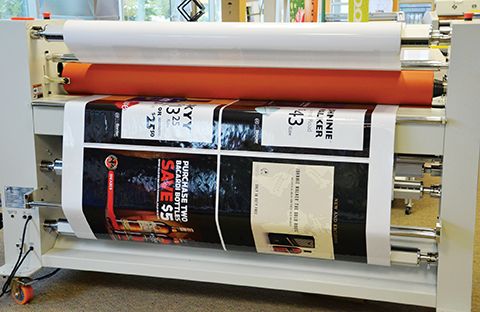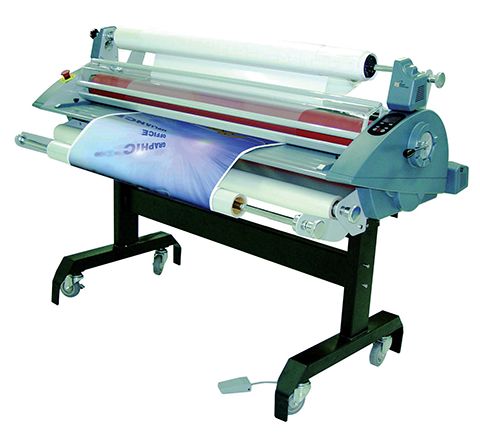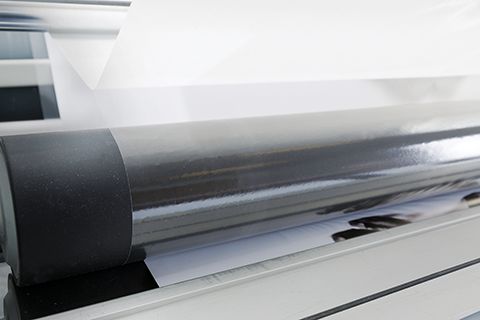Wide-format Printing: Tips for laminating display graphics
by all | 18 September 2015 10:03 am
 [1]
[1]Photo courtesy Drytac
By Jim Hingst
There is usually more than one way to do something. In the sign industry, for example, print service providers (PSPs) have devised many different techniques for laminating display graphics, with an eye on preventing mishaps, saving production time and improving profitability.
Safety
The safety precautions outlined in the lamination equipment manual should be reviewed with employees. To start, they should never wear loose clothing when operating the machinery.
Similarly, long hair should be tied back. This is not just for safety; wearing a hairnet can also help prevent any hair from falling onto a print and being encapsulated.
Power should be disconnected when wiping down the rubber rollers with a lint-free rag and mild, non-abrasive cleaners, then reconnected when the rollers need to be advanced, making sure to keep hands away from moving parts.
Compatibility
The interaction of inks, substrates, printing and lamination involves very complex chemistry. Incompatibility between components can adversely affect the ability of the overlaminate to adhere to the print, resulting in delamination. This is why it is important to test and evaluate the raw materials before a production run.
Similar films expand and contract at the same rate, while dissimilar films do not, so a calendered vinyl film should be used with a calendered vinyl overlaminate and a cast vinyl film should be used with a cast vinyl overlaminate.
That said, it is hard to go wrong with a cast vinyl overlaminate. These films can be used on printed cast, calendered or extruded vinyl graphics.
One of the problems to watch out for is how a dissimilar overlaminate can delaminate from the base film or a ‘tunnel’ could form between the two products. Overlamination problems can also result when a print is mounted to a substrate that expands and contracts at a high rate. The resulting tension between the graphic and the laminating film can cause tunnelling or delamination.
Storage
There are right and wrong ways to store overlaminates and other pressure-sensitive materials, such as application tape and vinyl.
The wrong way is to stack rolls of unboxed overlaminates horizontally. This can create flat spots in the rolls, which can appear as a visible line after the overlaminate is applied to the print.
The right way is to keep the rolls in their boxes and stacked upright until they are needed. (While the corrugated boxes are designed to withstand the rigours of shipping, stacking them horizontally can result in their collapse when overall weight becomes excessive.)
The best storage area is the printing room, ideally at 21 C (70 F) with 50 per cent relative humidity. Under these conditions, overlaminates should have a shelf life of more than one year.
The ideal shop environment is also spotlessly clean. If machinery is cleaned with an air hose, however, dirt or dust can become airborne, settle on the raw materials and eventually become trapped between graphics and overlaminates, which usually results in ‘tenting’ of the laminating film over trapped particles. This is why, as mentioned earlier, laminator’s rollers should be cleaned with a lint-free rag instead.
 [2]
[2]The interaction of inks, substrates, printing and lamination involves complex chemistry. Photo courtesy Royal Sovereign
Drying time
Before an overlaminate film is applied to a print, the ink must be completely dry. If it is not cured, the graphic risks bubbles under the laminate, yellowing of the substrate and the overlaminate and/or migration of solvents through the film into the adhesive, causing adhesion failure.
Print drying time varies, depending on ink density, ambient temperature and humidity. Also, even when a graphic feels dry to the touch, the ink may not yet be completely cured. It is important to consult the manufacturer’s recommendations for drying time and, as a rule of thumb, to wait 24 hours before laminating any print and then to let the laminated print lay flat for another 24 hours before rolling or mounting it.
Threading the laminator
All laminators have different optimal settings. Before threading an overlaminate through a roll laminator, for instance, it is important to study the manufacturer’s diagram(s) for doing so. A laminated print’s finished appearance can be affected by several variables at this stage, including the feed roller’s unwind tension, the nip rollers’ pressure and the laminating speed.
After loading and securing the overlaminate roll on the unwind shaft, the tension on the roll should be low and it should not be able to shift from side to side. As a general rule, the least amount of tension should be used to accomplish the job.
That said, the unwind rollers should not be allowed to ‘free-wheel.’ A slight degree of tension is necessary to ensure the overlaminate feeds evenly into the nip rollers. And some back tension will prevent wrinkling and trapped air bubbles.
If the tension is too high, however, it will stretch the overlaminate. Many stretched films, especially polyester-based ones, have a ‘memory’ and tend to shrink back to their original shape, which can cause a laminate to curl and/or delaminate.
Setup
The laminator’s rolls should be regularly inspected and properly adjusted to ensure they remain in good condition. Otherwise, rolls that are not perfectly smooth and parallel—and where pressure is not consistent—can cause trapped air bubbles, wrinkling and poor adhesion. Adjusting roll pressure for consistency can be frustrating if the machinery uses screws instead of air cylinders for this purpose.
Laminator manufacturers typically recommend periodic testing of the rolls’ ‘footprint,’ which involves positioning sheets of special nip impression transfer paper across the web, closing the hot rolls, removing the sheets and inspecting them. Inconsistent impressions will indicate unevenness in pressure across the web, which can result from concave, convex or canted rolls.
 [3]
[3]All laminators have different optimal settings for threading an overlaminate through the rolls. Photo courtesy RTape
Speeds and settings
Pressure-sensitive films usually laminate better at slower speeds, e.g. in the range of 0.9 to 1.5 m (3 to 5 ft) per minute. Pressure-sensitive overlaminates require pressure so their adhesive properly flows out and makes complete contact with the print surface. Insufficient pressure can result in ‘silvering’ and the formation of air bubbles. Conversely, excessive pressure can cause wrinkling and curling of the print.
Overlaminates generally require 207 to 345 kPa (30 to 50 psi) of pressure. If air bubbles appear, the nip pressure should be increased, the lamination speed should be slowed down and, if worse comes to worse, a little heat should be added. Thicker overlaminates, including 0.13 to 0.38-mm (5 to 15-mil) thick polycarbonate films, typically require higher pressure settings. One option is to use a ‘sled’—i.e. a 3-mm (0.12-in.) thick polycarbonate or acrylic sheet—underneath the print to help increase and even out the pressure across the laminator’s web.
There are opposing arguments with regard to the application of heat when laminating a pressure-sensitive film. Some people say it allows the overlaminate’s adhesive to flow out better, in turn achieving a stronger bond and preventing silvering. Others point out heat can cause the overlaminate to stretch, such that after it cools, it contracts and can thus delaminate from the print. As heat can also cause other problems, including waviness, tunnelling and wrinkles, it is best not to use it except when absolutely necessary.
Rolling laminated prints
Laminated prints should be stored and shipped flat whenever possible, especially those using polyester-based overlaminates. If graphics must be rolled, a flexible overlaminate like vinyl is preferable and the printed image should be on the outward-facing side of the roll.
The print should also not be rolled too tightly or tunnelling could result between the overlaminate and the print. The outside diameter of the rolled film’s core should be no less than 152 mm (6 in.) for a vinyl overlaminate on a vinyl print and no less than 305 mm (12 in.) for graphics protected with a 0.13 to 0.38-mm (5 to 15-mil) vinyl or polycarbonate overlaminate. In other words, the thicker the overlaminate, the larger the core diameter should be.
Cleaning graphics
Finally, customers will need to be taught how to properly care for their newly delivered graphics. Laminated prints should be washed with sponge or soft rag—as hard bristle brushes can scratch the surface, especially with 0.08-mm (3-mil) thick polyvinyl chloride (PVC) films—and a mild, non-abrasive cleaner that is neither too acidic nor too alkaline and does not contain strong solvents. After cleaning, the graphics should be dried using a soft, clean cloth towel, avoiding paper towels that could also scratch the overlaminate.
Jim Hingst is a 42-year veteran of the graphic arts field who retired from application tape and premask manufacturer RTape earlier this year. For more information, visit his blog at www.hingstssignpost.blogspot.ca[4].
- [Image]: http://www.signmedia.ca/wp-content/uploads/2015/09/PhotoCourtesyDrytac.jpg
- [Image]: http://www.signmedia.ca/wp-content/uploads/2015/09/PhotoCourtesyRoyalSovereign.jpg
- [Image]: http://www.signmedia.ca/wp-content/uploads/2015/09/PhotoCourtesyRTape.jpg
- www.hingstssignpost.blogspot.ca: http://www.hingstssignpost.blogspot.ca
Source URL: https://www.signmedia.ca/wide-format-printing-tips-for-laminating-display-graphics/